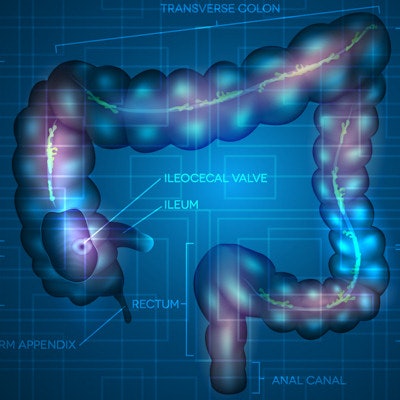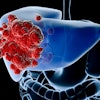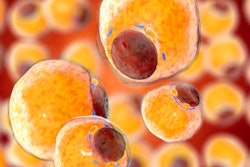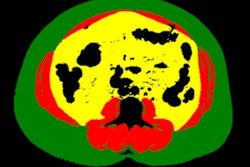
Body composition measurements -- specifically visceral adipose tissue and muscle radiodensity -- obtained from the routine CT scans of patients with colorectal cancer could help identify those at the greatest risk of major adverse cardiac events, according to an article published online May 16 in JAMA Oncology.
Prior research has suggested that risk of cardiovascular disease is up to four times greater for patients who survive colorectal cancer than for those without a history of cancer, in large part due to shared risk factors related to obesity. A recent study, for example, estimated that more than half of U.S. patients with stage I to III colorectal cancer who were at least 65 years old would develop cardiovascular disease within 10 years of cancer diagnosis, noted Justin Brown, PhD, from the Pennington Biomedical Research Center and colleagues.
To facilitate the early identification of high-risk patients, the researchers explored potential associations between body composition measurements obtained on CT during cancer diagnosis and major adverse cardiac events.
Their cohort consisted of 2,839 patients from the Colorectal Cancer: Sarcopenia, Cancer, and Near-term Survival (C SCANS) trial who underwent a CT scan for colorectal cancer diagnosis followed by surgical treatment. The average age of the population was 61.9, and the 10-year incidence of major adverse cardiac events, including heart attack and death, was 19.1%.
Among all body composition measurements, the researchers found that increasing levels of visceral adipose tissue and decreasing muscle radiodensity (i.e., growing amounts of fat stored in the muscle) on CT had statistically significant associations with major adverse cardiac events. In contrast, they found no significant association between cardiac events and body mass index (BMI), muscle mass, or subcutaneous adipose tissue.
| Associations between CT body measurements and cardiac events in colon cancer patients | |||||
| Visceral adipose tissue (cm2) | |||||
| < 53 | 53.9-106.2 | 106.3-163.6 | 163.7-238 | ≥ 238.1 | |
| Cardiac events | 7.2% | 10.9% | 12.7% | 14.6% | 19% |
| Muscle radiodensity (Hounsfield unit) | |||||
| < 31.5 | 31.5-37.5 | 37.6-42.5 | 42.6-48 | ≥ 48.1 | |
| Cardiac events | 22.8% | 14.8% | 10.9% | 9.5% | 6.3% |
The findings suggest that visceral fat levels and muscle quality collected from routine CT scans could help assess risk for major adverse cardiac events in patients with colorectal cancer, independent of traditional risk factors such as smoking, hypertension, and type 2 diabetes, the authors noted. Physicians may thus benefit from integrating these quantitative measures into cardiovascular risk management for this population.
"This precision prevention approach to cardiovascular risk management may help to cost-effectively allocate limited resources such as dietary and physical activity counseling to patients who may be most likely to benefit from lifestyle counseling," they wrote.
Furthermore, these results should prompt future investigations into interventions that can help reduce visceral adiposity and enhance muscle quality, Michael Passarelli, PhD, from Dartmouth-Hitchcock Medical Center noted in an accompanying editorial.
"Studies designed to assess body composition change over time may also reveal novel insights. ... Understanding whether body composition profiling can identify those susceptible to cardiac toxic effects from colorectal cancer treatments such as fluorouracil or capecitabine is also imperative," he concluded.



















